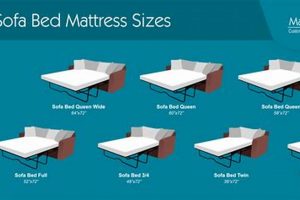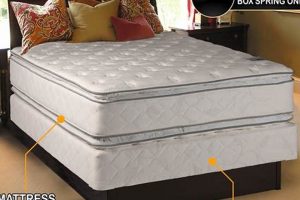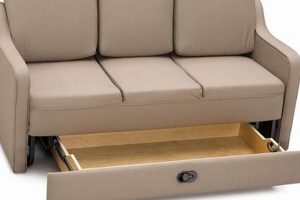A portable sleeping solution designed for the cab of a commercial vehicle, this product offers a comfortable resting space during long hauls or overnight stops. Typically inflatable and crafted from durable materials, it transforms the limited space into a temporary bedding area. Its dimensions are tailored to fit within the confines of a truck’s interior, maximizing available room while providing a supportive surface for rest.
The implementation of such a device significantly enhances driver well-being and potentially improves safety. By offering a means for adequate rest, it combats fatigue, a leading cause of accidents in the transportation industry. Historically, drivers relied on uncomfortable seating or improvised bedding, leading to inadequate sleep. This product represents a dedicated and improved solution, contributing to better rest and, consequently, improved alertness and performance on the road. Additionally, using this air bed offers some cost effectiveness because drivers will be able to rest well and avoid sleeping in costly hotels.
The subsequent sections will delve into the various types available, factors to consider when selecting one, proper inflation and maintenance techniques, and safety considerations for using this equipment within a commercial vehicle setting.
Guidance on Selecting and Utilizing Truck Air Bed Mattresses
Effective use of a sleeping solution within a commercial vehicle necessitates careful consideration. The following guidelines enhance comfort, safety, and longevity.
Tip 1: Size Verification is Paramount. Prior to purchase, meticulously measure the available space within the truck cab. Ensure the selected product dimensions align precisely, preventing obstruction of vehicle controls or hindering movement.
Tip 2: Material Durability Impacts Longevity. Opt for materials resistant to punctures and abrasions. Heavy-duty PVC or reinforced nylon offers increased resilience against the rigors of frequent use and potential contact with sharp objects within the cab.
Tip 3: Inflation Method Considerations are Crucial. Assess the inflation options. Models equipped with built-in electric pumps offer convenience, whereas manual pumps demand physical exertion. Prioritize models with reliable and efficient inflation/deflation mechanisms.
Tip 4: Comfort Enhancement Features are Beneficial. Explore models incorporating integrated pillows or contoured surfaces. These features contribute significantly to improved sleep quality and reduced musculoskeletal strain during rest periods.
Tip 5: Secure Placement is Non-Negotiable. Implement measures to prevent shifting during transit. Utilize integrated straps or non-slip surfaces to anchor the product securely. Unsecured items pose a safety hazard during vehicle operation.
Tip 6: Regular Maintenance Prolongs Lifespan. Routinely inspect for leaks or damage. Clean the surface with appropriate cleaning agents to prevent bacterial growth and maintain hygiene within the sleeping environment.
Tip 7: Temperature Regulation Matters. Consider the impact of ambient temperature on the product’s firmness. Air pressure fluctuates with temperature, requiring occasional adjustments to maintain optimal support. Use of a thermal blanket may be useful in colder temperature for insulation.
Adherence to these principles will promote a restful and safe experience, contributing to driver well-being and enhanced operational safety.
The subsequent section will address common issues, troubleshooting, and advanced utilization strategies.
1. Dimensions
The dimensional characteristics of a sleeping surface directly correlate to its usability and effectiveness within the confined space of a truck cab. Accurate sizing is paramount for ensuring comfort, safety, and functionality.
- Length and Width Compatibility
The length and width must precisely match the available area within the sleeper berth or cab. Insufficient dimensions negate the intended benefits, while excessive dimensions obstruct vehicle controls and create safety hazards. For example, a unit designed for a full-size sleeper berth will be unsuitable for a day cab, impeding access to essential functions.
- Thickness and Headroom Considerations
The inflated thickness impacts available headroom. Excessive thickness reduces vertical space, potentially causing discomfort or impeding movement. This is especially critical in cabs with low roofs. The selected thickness must strike a balance between comfort and headroom availability.
- Rolled or Folded Size for Storage
When not in use, the product must be storable without significantly impacting available cargo space or driver legroom. The rolled or folded size dictates ease of storage. Models with compact storage profiles are preferred, particularly in vehicles with limited storage compartments.
- Weight Distribution and Cab Stability
The dimensions, in conjunction with material composition, influence weight distribution. Uneven weight distribution can affect cab stability and potentially impact vehicle handling. Uniform weight distribution is desirable for maintaining vehicle stability and driver control.
In conclusion, the dimensions of a sleeping solution are not merely measurements; they are critical parameters that determine its practicality, safety, and impact on the driver’s work environment. Selecting a product with appropriate dimensions is a prerequisite for successful implementation and realization of its intended benefits.
2. Material Durability
Material durability constitutes a critical factor in determining the longevity and overall value of a portable sleeping solution designed for truck cabs. The operating environment subjects the product to significant stress, demanding robust materials capable of withstanding frequent use and potential hazards.
- Puncture Resistance
The material’s ability to resist punctures from sharp objects within the cab, such as tools or improperly stored cargo, is paramount. Materials such as heavy-duty PVC or reinforced nylon exhibit higher puncture resistance compared to standard plastics. A puncture compromises the product’s primary function, rendering it unusable until repaired and causing inconvenience to the driver.
- Abrasion Resistance
Frequent rubbing against cab surfaces, particularly during vehicle movement, causes abrasion. Materials with high abrasion resistance, such as those treated with protective coatings or possessing inherently durable weaves, maintain their structural integrity over time. Reduced abrasion minimizes air leakage and prolongs the product’s lifespan.
- Tensile Strength
Tensile strength, representing
the material’s ability to withstand stretching forces, is crucial for maintaining shape and preventing seam failures. Repeated inflation and deflation cycles place stress on the seams and material itself. High tensile strength ensures the product retains its intended form and prevents premature degradation. - Environmental Degradation Resistance
Exposure to temperature fluctuations, UV radiation, and chemicals common in truck interiors necessitates resistance to environmental degradation. Materials prone to cracking, fading, or becoming brittle when exposed to these elements diminish the product’s lifespan and compromise its performance. UV-resistant coatings and chemically inert materials mitigate these effects.
The interplay between these facets of material durability directly impacts the long-term cost-effectiveness of a sleeping solution. While initial price may be a factor, products constructed from inferior materials necessitate more frequent replacement, ultimately increasing the overall expense. Investing in a solution crafted from durable materials represents a prudent decision, ensuring reliable performance and minimizing downtime associated with repairs or replacements.
3. Inflation System
The inflation system is an integral component of a portable sleeping solution for commercial vehicles, directly impacting user convenience, setup time, and overall product functionality. Its design and operational characteristics dictate the ease with which the product can be prepared for use and subsequently deflated for storage.
- Integrated Electric Pumps
Models equipped with integrated electric pumps offer convenience by automating the inflation process. These pumps typically connect to the vehicle’s 12V DC power outlet, eliminating the need for manual exertion. Inflation time is minimized, allowing drivers to quickly prepare their sleeping area during rest stops. However, reliance on the vehicle’s electrical system necessitates consideration of power draw and potential battery drain, particularly during extended use without the engine running.
- External Manual Pumps
External manual pumps, such as foot pumps or hand pumps, provide an alternative inflation method. These pumps offer independence from the vehicle’s electrical system, making them suitable for situations where power access is limited or undesirable. However, manual inflation requires physical effort and may be less efficient compared to electric pumps. The pump’s design and capacity influence the inflation time and the level of exertion required.
- Inflation Valve Design
The design of the inflation valve impacts the speed and efficiency of both inflation and deflation. Valves with wider openings facilitate faster airflow, reducing inflation and deflation times. Secure valve closure is essential to prevent air leakage during use. Durable valve materials and robust construction ensure long-term reliability and prevent premature failure.
- Inflation Pressure Regulation
Maintaining optimal inflation pressure is crucial for achieving both comfort and structural integrity. Overinflation can stress the seams and material, potentially leading to damage. Underinflation compromises support and comfort. Some systems incorporate pressure gauges or pressure relief valves to assist in maintaining the appropriate inflation level. Accurate pressure regulation extends the product’s lifespan and optimizes its performance.
The selection of an appropriate inflation system involves balancing convenience, efficiency, and reliability. While integrated electric pumps offer ease of use, manual pumps provide independence from the vehicle’s electrical system. The inflation valve design and pressure regulation mechanisms directly impact the product’s performance and longevity. Prioritizing a robust and efficient inflation system is essential for ensuring a positive user experience and maximizing the benefits of a portable sleeping solution within a commercial vehicle.
4. Comfort Features
The integration of specific comfort features into a portable sleeping solution significantly impacts the quality of rest obtained by commercial vehicle operators. These features address the unique challenges posed by the often-restrictive and physically demanding nature of long-haul driving, aiming to mitigate discomfort and promote restorative sleep.
- Integrated Pillow Support
The inclusion of an integrated pillow or raised headrest provides essential neck and head support. This feature alleviates strain on the cervical spine, reducing the likelihood of headaches and neck pain, common complaints among drivers who spend extended periods in fixed postures. The ergonomic design of the pillow should conform to the natural curvature of the neck, promoting proper spinal alignment during sleep. Absence of such support necessitates reliance on improvised solutions, often resulting in inadequate posture and compromised sleep quality.
- Contoured Surface Design
A contoured surface, incorporating raised sections or strategically placed indentations, distributes weight more evenly across the body. This minimizes pressure points, particularly in the shoulders, hips, and lower back. By conforming to the body’s natural curves, a contoured design enhances circulation and reduces the risk of numbness or tingling, which can disrupt sleep. A flat, uniform surface, conversely, concentrates pressure on specific areas, potentially leading to discomfort and restlessness.
- Ventilation and Breathability
Materials with enhanced ventilation and breathability facilitate airflow, mitigating heat buildup and moisture accumulation during sleep. The absence of adequate ventilation can result in overheating, sweating, and a generally uncomfortable sleeping environment. Materials such as perforated foams or breathable fabrics promote air circulation, wicking away moisture and maintaining a more consistent temperature. This contributes to improved sleep quality, particularly in warmer climates or during periods of high exertion.
- Noise and Vibration Dampening
Certain materials and construction techniques offer inherent noise and vibration dampening properties. This is particularly beneficial in the noisy environment of a truck cab, where external sounds and engine vibrations can disrupt sleep. Multi-layered construction or the incorporation of sound-absorbing materials reduces the transmission of noise and vibration, creating a more tranquil sleeping environment. This enhances the likelihood of achieving deeper, more restorative sleep, minimizing the negative impact of external disturbances.
These comfort-enhancing features collectively contribute to a more restful and restorative sleep experience for commercial vehicle operators. The strategic integration of integrated pillow support, contoured surface design, ventilation, and noise dampening addresses the specific challenges posed by the truck cab environment, promoting driver well-being and potentially enhancing overall safety and performance.
5. Secure Fit
r>
A secure fit constitutes a non-negotiable safety and functional prerequisite for any inflatable sleeping surface intended for use within a commercial vehicle. Its absence introduces potential hazards and undermines the intended benefits of providing a comfortable and restful environment for the driver.
- Prevention of Displacement During Transit
An unsecured product can shift or slide during vehicle movement, particularly during braking, acceleration, or cornering. Such displacement compromises the driver’s ability to access controls, potentially leading to accidents. Integrated straps, non-slip surfaces, or strategically placed anchors are essential for maintaining a stable position. Failure to secure the product effectively transforms it into a mobile hazard within the cab.
- Maintenance of Consistent Support and Stability
Movement of the sleeping surface disrupts its intended weight distribution and support characteristics. Shifting can create uneven pressure points, leading to discomfort and hindering restful sleep. A secure fit ensures the product remains firmly in place, providing consistent and predictable support throughout the driver’s rest period. This is particularly critical for individuals with back problems or other musculoskeletal sensitivities.
- Minimization of Wear and Tear on the Product
Unsecured movement causes friction against cab surfaces, accelerating wear and tear on the material. Abrasions, punctures, and seam stress are exacerbated by constant shifting. Securing the product minimizes this friction, extending its lifespan and reducing the likelihood of premature failure. Properly securing the product is as important as the quality of the material it is made from.
- Compliance with Safety Regulations and Best Practices
Many commercial vehicle regulations and industry best practices emphasize the importance of securing all objects within the cab to prevent hazards during transit. Failure to comply with these regulations can result in penalties and increased liability in the event of an accident. A secure fit demonstrates a commitment to safety and aligns with established industry standards.
In essence, a secure fit transforms a potentially hazardous item into a valuable asset for driver well-being and safety. Integrating mechanisms to prevent movement should be considered an essential feature, not merely an optional add-on, when selecting an inflatable sleeping surface for commercial vehicle use. Its presence directly translates to a safer and more comfortable working environment for the driver.
Frequently Asked Questions About Truck Air Bed Mattresses
This section addresses common inquiries regarding the use, maintenance, and selection of sleeping solutions designed for commercial vehicle cabs. The intent is to provide clear and concise answers based on industry standards and best practices.
Question 1: What are the primary advantages of utilizing a truck air bed mattress compared to conventional sleeping methods within a commercial vehicle?
A dedicated sleeping surface offers improved comfort and support compared to resting directly on seats. Such a mattress also promotes better posture and reduces muscle strain. The improved rest quality achieved contributes to reduced driver fatigue and enhanced safety.
Question 2: What factors should be considered when determining the appropriate size and dimensions of a truck air bed mattress for a specific vehicle?
Measure the available space within the sleeper berth or cab meticulously. Ensure the product dimensions align precisely, preventing obstruction of vehicle controls or hindering movement. Account for both length, width and the impact of thickness on headroom. Verify that the mattress fits when inflated and also consider its folded size when it needs to be stored.
Question 3: What materials offer the best combination of durability, comfort, and ease of maintenance for a truck air bed mattress?
Heavy-duty PVC or reinforced nylon provide increased resilience against punctures and abrasions. These materials are also relatively easy to clean. Breathable fabrics or perforated surfaces enhance ventilation, improving comfort during sleep. Select the appropriate material and follow the manufacturer’s care instructions.
Question 4: What safety precautions should be observed when using a truck air bed mattress within a commercial vehicle environment?
Secure the product to prevent shifting during transit. Ensure it does not obstruct vehicle controls or impede emergency egress. Follow all applicable regulations regarding the safe operation of vehicles. Do not inflate the mattress to excess.
Question 5: How can the lifespan of a truck air bed mattress be extended through proper maintenance and care?
Routinely inspect for leaks or damage. Clean the surface with appropriate cleaning agents. Avoid exposure to extreme temperatures and direct sunlight when not in use. Store the product in a clean, dry environment. Proper care should yield years of productive use.
Question 6: What are the potential drawbacks or disadvantages associated with using a truck air bed mattress?
Potential drawbacks include the need for inflation and deflation, the possibility of punctures, and the space required for storage when not in use. Properly maintaining the product, using the correct dimensions, and careful use should mitigate these disadvantages.
In summary, using a sleeping mattress in a commercial vehicle presents numerous benefits, but the driver must consider dimensions, materials, safety precautions and regular maintenance practices to derive the greatest benefits.
The next article will discuss advanced safety tips and considerations for the commercial truck drivers.
Truck Air Bed Mattress
This exploration has underscored the pivotal role of the truck air bed mattress in enhancing driver well-being and safety within the commercial transportation sector. Considerations ranging from dimensional accuracy and material durability to inflation system efficiency and secure fit have been addressed. These factors collectively influence the effectiveness of this equipment in mitigating driver fatigue and promoting restful sleep, crucial for maintaining alertness and preventing accidents.
The responsible selection, utilization, and maintenance of a truck air bed mattress represent a significant investment in driver health and operational safety. Adherence to the principles outlined herein will contribute to a more sustainable and responsible approach to commercial transportation, prioritizing the welfare of those who serve as its backbone.






![Best Blow Up Mattress for Sofa Bed [Guide & Reviews] Organic & Natural Mattress Buyer’s Guide: Non-Toxic Sleep Solutions Best Blow Up Mattress for Sofa Bed [Guide & Reviews] | Organic & Natural Mattress Buyer’s Guide: Non-Toxic Sleep Solutions](https://mattressworldpa.com/wp-content/uploads/2025/07/th-7138-300x200.jpg)
